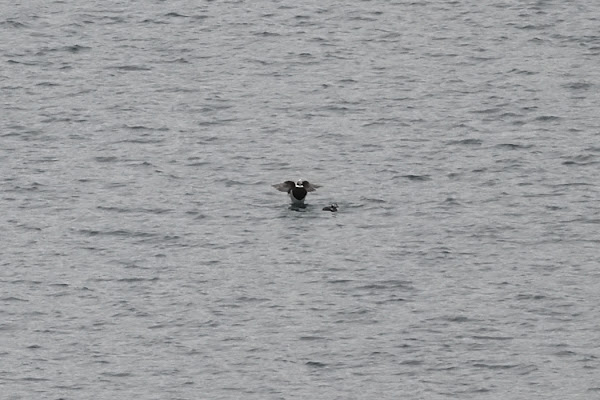With rain and the potential for strong storms expected to move in late in the day, I thought it might be a good day for early migrants. At around noon, I noticed a text message from Adam Miller about 3 Canvasbacks he saw at the Hollo Road pond. I headed for Hollo Road and easily found the male and two females there.
Adam had also reported 2 Long-tailed Ducks below the Martins Creek boat launch, so I drove over there. The only birds there were 3 Common Mergansers and a few Mallards, but the nearby retention pond held several species of waterfowl that included 59 Green-winged Teal, 28 Ring-necked Ducks, 9 Buffleheads, 3 Snow Geese, 2 Northern Shovelers, a Mute Swan, and 2 Scaup that were too far away to identify to species in the buffeting wind.
While there, Scott Singer texted that there were 2 Long-tailed Ducks at the Nazareth Quarry, so that was my next stop. When I got there, Scott had the pair in the scope. I worked on getting some long-range documentation photos of them.
Also there were 4 Red-breasted Mergansers, a male and three females.
Three Cackling Geese were among the 26 Canada Geese.
There were 14 additional species of waterbirds present that included 62 Ruddy Ducks, 21 Green-winged Teal, 17 American Black Ducks, 13 American Coots, 12 Ring-necked Ducks, 9 Common Mergansers, 4 Gadwall, 4 Buffleheads, 3 Canvasbacks that were probably the same ones that were at Hollo Road earlier, 3 Mallards, 2 Wood Ducks, 2 Horned Grebes, a Pied-billed Grebe, and a Snow Goose, plus 3 American Robins, 2 Common Ravens, and a Ring-billed Gull.
I checked Green Pond, which didn't hold anything significant and then drove to the Regency ponds. The ponds are being drained to try and find a leak there, so the water levels were very low. I found a pair of American Wigeon in the south pond and several Killdeer in the north pond.
My last stop on the way home was at the Newburg Road retention pond behind the hospital. There, I was surprised to find a Wilson's Snipe and a female Common Merganser.
As expected, it was a very good day that produced several uncommon species and very good numbers of the more expected ones.

















No comments:
Post a Comment